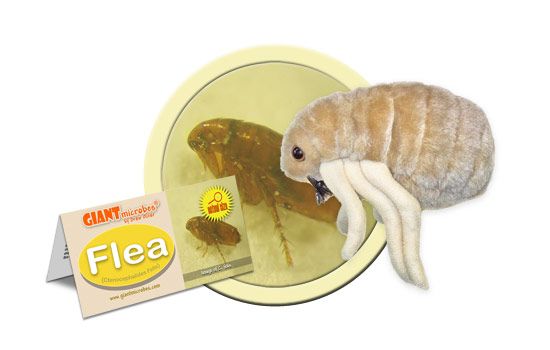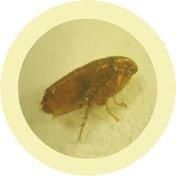Flea (Ctenocephalides felis)
Product Details
Additional Information
| Sizes | Giantmicrobes are based on actual microbes, cells, organisms and other critters, only 1,000,000 times actual size! Gigantic (GG) 16-24" XL (XL) 10-15" Original (PD) 5-8" Keychain (KC) 2-4" with clip |
|---|---|
| Materials | Plush from all new materials. Stuffed with polyester fiber fill. Surface washable: sponge with water & soap, air dry. |
| Packaging | Each plush microbe includes a printed card with fun, educational and fascinating facts about the actual microbe or cell. |
| Safety | Every product meets or exceeds U.S. and European standards for safety. For ages 3 and up. |
All about Flea (Ctenocephalides felis)
FACTS: The flea's diminutive size has made it a global symbol of insignificance. But as carriers of typhus and tapeworms – not to mention bubonic plague – fleas will not be ignored.
One of the original subjects of microscopic examination (early microscopes were called "flea glasses"), fleas can now boast of nearly 3,000 identified species. The most commonly encountered is the cat flea, Ctenocephalides Felis, but despite its name, it is broad-minded with respect to hosts and will happily affix itself to dogs – as well as their best friends!
If you encounter a flea, thorough vacuuming, twice a day for several weeks, is recommended. A single flea can lay hundreds of eggs, so you don't want to miss any. (And if you do, call for help: professional exterminators should be able to handle the problem.)
Of course, fleas are hardly all-work-and-no-play: they have the noted abilities to jump hundreds of times their own height and carry loads hundreds of times their own weight. These remarkable skills probably account for the creation of circuses designed to highlight other remarkable flea-talents such as playing in an orchestra, dancing, juggling, fencing, and a variety of other diverting activities. So if all else fails, send in the clowns.
| Name | Ctenocephalides Felis |
|---|
| Actual Size | 1.5 to 3 mm long |
|---|
| Where It Lives | Fleas are known to live on dogs, but fleas can be found on humans and other warm-blooded animals! |
|---|
| Symptoms | Reddish marks (rash) on skin; small itchy bumps that may bleed. Bites are often around the waist, ankles, armpits, and in the bend of the elbows and knees. |
|---|
| Cure | Pesticides are used to treat the house, pet, and outside areas. To relieve the itch, an over-the-counter 1% hydrocortisone can be used. |
|---|
| History |
The oldest known species of fleas was found 35 to 50 million years ago. The black plague took over 14th century Europe and killed 25 million people. This plague was brought on by fleas that spread a bacterium throughout the European population. Later on, the plague hit Egypt, Africa, China, India, and the U.S. as well. In total around 200 million people died of the plague. Today, there are a few cases of the black plague, also known as the bubonic plague, each year in the United States. |
|---|
| Fascinating Facts | Fleas are able to jump as high as 34 inches – that’s the equivalent to a human leaping over 1,000 feet! Now that’s Olympic gold worthy. |
|---|






